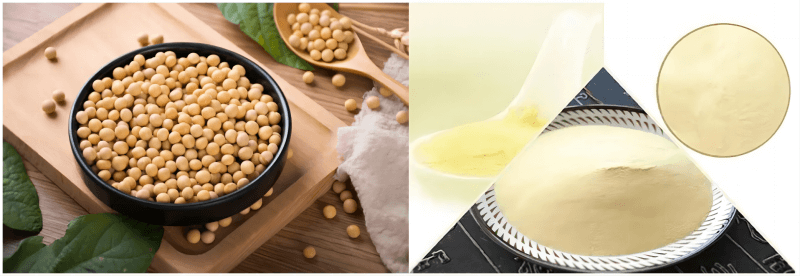Soy protein isolate (SPI) is a highly versatile and functional ingredient that has gained popularity in the food industry due to its numerous benefits and applications. Derived from low-temperature defatted soybean meal, soy protein isolate undergoes a series of extraction and separation processes to remove non-protein components, resulting in a protein content of over 90%. This makes it an excellent source of high-quality protein, low in cholesterol and fat-free, making it a healthier option for consumers. With its ability to aid in weight loss, lower blood lipids, reduce bone loss, and prevent cardiovascular and cerebrovascular diseases, soy protein isolate has become a valuable ingredient in various food products.

One of the key features of soy protein isolate is its functionality in food applications. It possesses a wide range of functional properties, including gelling, hydration, emulsifying, oil absorbing, solubility, foaming, swelling, organizing, and clumping. These properties make it a versatile ingredient that can be utilized in a variety of food products across different industries. From meat products to flour products, aquatic products, and vegetarian products, soy protein isolate offers a multitude of functional benefits, making it an essential component in the formulation of various food items.
There are many ways to use soy protein isolate, such as:
(1) Dry addition: Add soy protein isolate to the ingredients in the form of dry powder and mix them. The general addition amount is about 2%-6%;
(2) Add in the form of hydrated colloid: Mix soy protein isolate with a certain proportion of water to form a slurry and then add it. Generally, 10%-30% of the colloid is added to the product;
(3) Add in the form of protein particles: Mix soy protein isolate with water and add glutamine transaminase to cross-link the protein to form protein meat. If necessary, color adjustment can be performed, and then it is formed by a meat grinder. Protein particles, generally added in an amount of about 5%-15%;
(4) Add in the form of an emulsion: mix soy protein isolate with water and oil (animal oil or vegetable oil) and chop. The mixing ratio is adjusted appropriately according to different needs, protein: water: oil = 1:5:1-2/1:4:1-2/1:6:1-2, etc., and the general addition ratio is about 10%-30%;
(5) Add in the form of injection: mix soy protein isolate with water, seasoning, marinade, etc., and then inject it into the meat with an injection machine to play a role in water retention and tenderization. Generally, the amount of protein added to the injection is about 3%-5%.

In conclusion, soy protein isolate offers a wide range of functionalities and applications in the food industry. Its high protein content, coupled with its functional properties, makes it an invaluable ingredient for food manufacturers looking to enhance the nutritional profile and functional characteristics of their products. Whether it's improving texture, enhancing moisture retention, or providing a source of high-quality protein, soy protein isolate continues to play a crucial role in the development of innovative and nutritious food products. As consumer demand for healthier and sustainable food options continues to grow, soy protein isolate is poised to remain a key ingredient in the formulation of a diverse range of food products.
Post time: Aug-09-2024